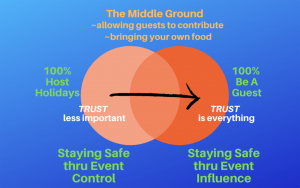Food allergies can definitely shape your holiday celebrations — how you choose to celebrate, where you choose to celebrate, and with whom you choose to celebrate. The key idea here is that YOU get to ‘choose’. Will you be a guest? Or will you host?
Hosting The Holidays With Food Allergies
As a food allergic family, you can optimize for safety during the holidays by making your home the go-to home for holiday celebrations.
The positives
When you host, you have the best shot at controlling all the variables that could trigger an allergic reaction. You’re the gatekeeper. You’re expert in your loved ones food allergies. You know what your loved one can eat safely. You read all the food labels. You determine which food ingredients come into your home, your fridge, your pantry. You determine how all the food is prepared and served.
The downside
At times it can be hard always taking the lead to host, especially if you have a big family and circle of friends you like to celebrate with:
- You might have more family & friends than you have space to gather, or
- You might live in a location that’s remote from your loved ones, or
- You might have loved ones who can’t travel easily or afford to travel, or
- You just might not have the time or the energy or the money to 100% host.
And sometimes, you just need to let other family members take a turn.
Being The Guest With Food Allergies
So, when you’re not the go-to house for holiday celebrations, what can you do to keep the joy in your celebration and the allergy worries at bay?
Communicate! Communicate! Communicate!
People are more aware than ever before that many people have special dietary needs, both medical and lifestyle — think celiac, keto, vegan, vegetarian, gluten free, whole foods-plant based, low glycemic, fodmap. This heightened awareness helps families who have food allergies. Why? Because it paves the way to easier food allergy conversations with holiday hosts.
Here’s a game plan to guide you through:
(1) Explain {re-explain} the facts.
Explain: Regardless of your relationship with the host — family member, friend, friend of a friend — it’s important to share all the facts about your family food allergies. Don’t skimp on details because it’s so much more than just what foods to avoid.
- Explain all the food allergies, allergen by allergen. It’s not enough to say ‘legumes’ or ‘tree nuts’. Name them.
- Provide clear examples of where your allergens can hide in common ingredients. Not everyone realizes that the marshmallow fluff Aunt Lynne uses to make her famous fudge most likely contains egg whites, or that Cousin Molly’s hummus dip most likely contains sesame (aka tahini), or that Grammy’s family cornbread recipe most likely contains dairy.
- Describe cross contact, how it can happen (via serving utensils, via guests’ unwashed hands, from a surface that wasn’t cleaned properly) and how it can be avoided.
- Describe how certain foods can aerosolize, like shellfish when steamed, or the dust from dry roasted peanuts and nuts.
Re-explain: Even if you’ve had The Allergy Conversation before, it’s important to have it again because your hosts have probably forgotten the nitty gritty details from the last round. Plus, your allergy situation may have changed over the past 12 months. Maybe your family added some new allergies or lost a few.
(2) Ask questions.
Beyond explaining your situation, you will want to fully understand your host’s plans. Remember, this is a two-way conversation. You’ll want to ask lots of questions so you can assess the risk to your loved one of eating food offered by your host.
- What’s the planned menu start to finish?
- How will the food be made? (Homemade by the host? Store bought? Catered? Potluck/contributed by other guests? Some combination of all?)
- Will there be appetizers and munchies before the main event and if so, what?
- How will the food be served (Individually plated and served from the kitchen? Served family-style at the table? Self-served from a buffet?)
- How will dessert work? (Individually plated and served from the kitchen? Served family-style at the table? Self-served from a buffet?)
(3) Be mindful of your communication style.
Are you being collaborative as you fact find? Or are you being demanding? Tone, body language, and volume all can determine how the message is received, even more than the words you actually use.
(4) Evaluate the risk to your loved one and decide what to do.
You need to walk away from this conversation with confidence that either your host clearly understands the allergy situation and is capable of providing safe food options, or not.
When you have confidence in your host, try to support their efforts to accommodate. Make it a collaborative effort by:
- Providing a list of safe brands, recipes, and trusted food vendors that work for your food allergy profile.
- Offering to explain the situation {educate} directly to caterers or others providing food for the gathering.
- Providing information on how to cook safely for a person with food allergies, if helpful.
- Suggesting reliable substitutes for ingredients that could be problematic.
- Asking your host to avoid serving foods with your allergens altogether. For example, our son is ANA to eggs and peanuts, as well as some other legumes. We’ve never hesitated to ask our holiday hosts to avoid serving food with his allergens. Because eggs are such a basic ingredient in dessert recipes, I often do double, even triple, duty on the dessert front, bringing pies, cookies and cakes, all made without eggs.
- Asking your host to save labels from the ingredients they use in their recipes so you can vet dishes before the holiday. One of our nieces, an amazing baker {and artist} takes baking egg-free cakes to the next level. Her cake creations are truly ART. She always texts us pictures of the food labels — from the flour to the dyes to the confectioner’s sugar — before she bakes the cake!
- Asking your host if you can sit next to your loved one with food allergies during the meal so you serve as a buffer between their plate and other guests’ plates.
- Asking your host if you can assemble your loved one’s plate of food behind the scenes in the kitchen before the meal is served to everyone else.
- Talking with your food allergic loved one about the food plans well before the gathering so they’re comfortable with the plans. You will want to manage their expectations about the meal, and find out what safe food they’d like to bring from home, just in case.
- Bringing back-up food, just in case. Despite best efforts, sometimes food plans at a gathering unravel and you need a Plan B.
- Role playing with your child in advance to prepare them for the unexpected. Help them find their words and practice how to politely turn down pro-offered food, how to excuse themselves so they can double check a food with you, how to politely ask someone to wash their hands after eating and before playing.
- Being quietly watchful. Share this responsibility with your partner or another trusted relative. Try to keep eyes on your food allergic loved one, even from a distance.
- Remembering to leave home with two autoinjectors, antihistamine and your action plan in your bag. Know where the nearest hospital is relative to your location, just in case.
When you don’t have confidence that safe food options will be available, here are suggestions for navigating a gathering with some peace of mind:
- Let your host know that you prefer to bring a safe meal from home for your allergic loved one, and that it may be a bit different from the menu they’ve planned. Be tactful. Be gracious.
- Offer to bring a number of allergy-friendly dishes for everyone to enjoy. Bringing some safe contributions from home could lighten the prep load for the host, and reduce any stress they feel about keeping your loved one safe at their table. Explain that it’s important for these dishes to be served separately from other dishes with dedicated utensils.
- Find an ally or two among other guests — people you trust to prepare food for your loved one with allergies — and see if they’d be willing to ask the host if they could also contribute an allergy-friendly dish or two to the gathering. For example, my sister-in-law’s son grew up with allergies similar to my son’s. I could always count on her to bring safe dishes that worked for both our boys.
- Talk openly with your child in advance of the Big Day about the need to bring safe food. Find out what special foods your child would like. Sushi was always a go-to option for our son, as was anything Chipotle. My son has always had allergy-friendly desserts to look forward
to that his cousin, Aunt and I make.
- Role play, role play, role play, teaching your loved one the in’s and out’s of navigating food-centric gatherings. Through this role play over time, you are actually equipping them for future solo-socializing, far from your watchful eye.
(5) Confirm it ALL in writing.
It’s important to put the information you share verbally in writing, too. A follow-up email can reinforce the importance of this information.
(6) Manage your expectations.
Be calm and patient when you explain the food allergy situation to your host, even if you’re explaining it to them for the umpteenth time. Keep in mind that you are in teacher-mode and food allergies are complicated. Put any frustration you feel aside. Remember that your host doesn’t live food allergies 24:7 like you do. If you do your job well, you will be able to add another person to your list of food allergy trustees.
(7) Stay flexible. Be ready to pivot if you must.
Your host may have the best of intentions, but fall short on execution. Don’t hesitate to go to Plan B after you arrive if you discover the lay of the land isn’t what you expected.
Be resolved to exit quickly if you feel the environment is unsafe. For example, we arrived at a family gathering after traveling across the country to get there, and found bowls of dry roasted peanuts scattered throughout the house. (It really was on us because we hadn’t had The Allergy Conversation before the event.) We made a beeline for the backyard with our son, and kept him outside until we could explain the situation and make a graceful getaway. Even removing the peanuts would not have helped, with peanut crumbs and dust flying everywhere. Our relatives were focused on their party. I think they sort of understood, but I don’t think they really understood.
(8) And if all else fails, you can always choose to opt-out and make other plans.
The Magic Kingdom and other magical places near and far await. Remember that the spirit of the holidays lives in your heart. Everything else is just icing on the cake.

So where’s your comfort zone? Do you need ‘Control’ to enjoy the holiday while staying safe? Or, can you get comfortable exerting only ‘Influence’ to stay safe? It’s a very personal decision.
“Now is no time to think of what you do not have. Think of what you can do with what there is.”
—Ernest Hemingway
Wishing you and yours a safe holiday season! Enjoy the little and the big moments with your loved ones, your extended family and friends.
Find joy. Give thanks.
 |
Empowering people to live more easily & safely with food allergies through technology and education. |
| About the Author: Gayle Rigione is CEO of Allergy Force, the food allergy management app. She’s also an allergy mom. She’s lived the heart stopping moments when her son ate the wrong thing, second guessed reactions and spent the night in the ER. These experiences inspire her to create tools for people with food allergies. Whatever you do, do it with a full heart. Audentes Fortuna Iuvat | |
Image: Image by Annie Spratt on Unsplash; Diagram by Allergy Force using Canva


